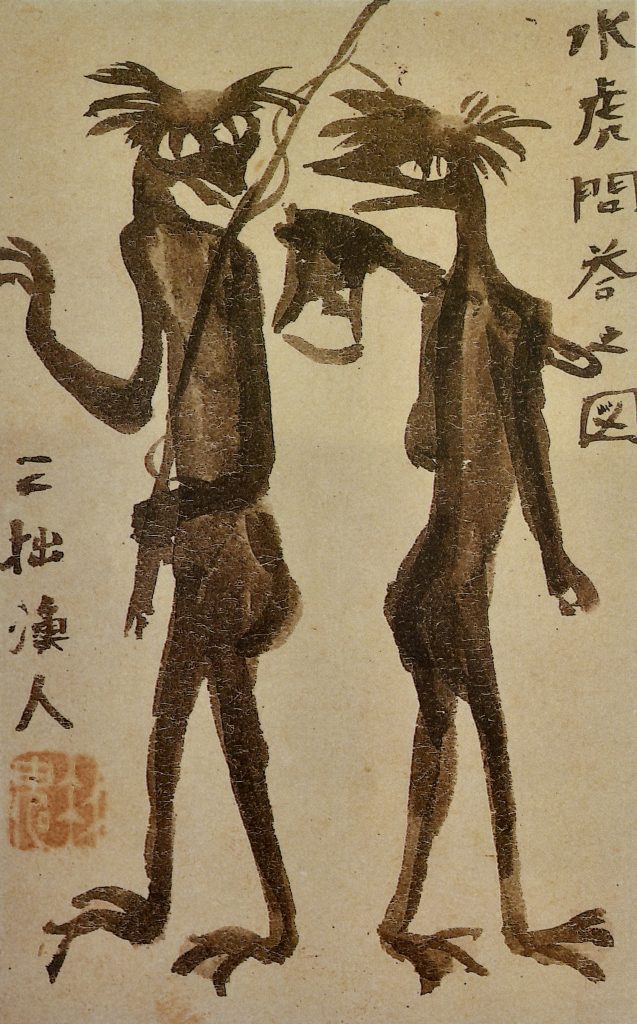Ryunosuke Akutagawa’s Kappa is a wonderland journey through Kappa Land narrated by Patient No 23, who has found himself in an insane asylum following his adventures. (My copy is translated by Allison Markin Powell & Lisa Hofmann-Kuroda.)
I have wunderworld projects on my mind these days – stories about adventures Elsewhere, in downstairs underworlds peopled by the dead or next-door wonderlands inhabited by curious characters. As I watch how masters like Akutagawa delve into their own wunderworlds, asking vivid questions as they explore, I can’t help but ask similar things of my own wunderworlds.
Below are a few of the inspiring wunderworld ideas I found in Kappa; maybe you’ll find similar inspiration for your own stories.
Prologue + distance from the protagonist
‘This is a story told by a certain psychiatric patient – Patient No 23, to be exact. It’s a story he tells to anyone that will listen.’
Kappa begins with a first-person prologue establishing that our soon-to-be-introduced narrator is in a mental asylum just outside Tokyo. (The story is from 1927.) Patient No 23 picks up the story in Chapter 1 and carries right on until the final chapter – with just one line of commentary in parentheses from the original narrator closing out the framing on the final page. (It’s a very short book, so we don’t really need additional encounters with the original narrator; a longer story may.)
I always like this extra layer. Getting a little distance from the hero gives you a lot of room to play – the protagonist may be mad, or dead, or mysteriously absent, or fictional. (This intro framing is especially fun in Don Quixote – Cervantes writes a funny introduction and then adds about six pages of poems in various styles by fictional poets.)
Classics: falling in and passing out
Getting into wunderworlds is always fun. In Kappa, Akutagawa has Patient No 23 encountering a strange creature – a kappa – and then chasing it. (Kappas are yokai that look a little like turtles; they live near riversides and play tricks on people.) It’s always fun to think of ways for people to enter wonderland; chasing a curious creature is classic.
Also – as the ‘transition’ from one world into another, Patient No 23 goes unconscious. (Again: classic.)
Manners – embodied in a second ring road cast of characters
Akutagawa is pretty straightforward in Kappa. Patient No 23 spends most chapters learning about a particular angle of life in Kappa Land, including: the nature of artists in kappa society; romantic customs among kappas; standard kappa behavior at concerts; and the economic and religious systems of Kappa Land. These are generally light episodes that are both ‘wonder’ and Akutagawa’s satirical takes on human society in the mid 1920s.
There are plenty of rich creative veins there for wunderland inspiration. For example – the chapter on religion made me wonder what an undersea cathedral in my wunderworld might look like (I’ve settled on tentacle spires that stretch down into an abyss).
Patient No 23 generally has one kappa friend from each of these areas of life, like Magg the philosopher and Tok the poet and Geyl, the capitalist owner of a glass company. That is one way to explore manners: simply allow the hero to hear about wonderland from various interesting characters who can embody various perspectives. This passive but interesting character work can alternate with active character action (like going to a concert); Akutagawa balances well between both. He doesn’t tend to linger anywhere, and both the action and the descriptions are generally kept breezy.
I like this idea of an extended ‘second ring road’ cast, each tied to a specific anchor. I have found myself tending to get hyper-focused on my main characters and forgetting to introduce fun guest stars; Akutagawa drops them in early, sitcom-style, so that it is easy to reincorporate them in any later scenes.
Rhythmic flexibility
On this topic of manners – Akutagawa shows that this mosaic style can provide an opportunity to be rhythmically flexible, slowing down for the most meaningful topic(s). Akutagawa lets a conversation between Patient No 23 and a kappa priest run a bit deeper than usual, allowing Akutagawa a lot of creative play room to depict how human religions appear to the kappas – and how kappa religion (called Nowism or Lifeism) appears to the kappas.
While Akutagawa is usually pretty brisk, he slows the pace a little in the chapter, using a deft change in gravity to pull the reader in more deeply than at any point before.
Exploration as conversation
Kappa is generally a ‘wonderland via conversation’ book. We learn about the kappas by talking to the kappas and, every now and then, going to a kappa event.
I like the slower pace of this sort of adventure; the benefit of wunderworlds is that the pace is up to us – we can have fast, episodic adventures or spend every day just chilling in the garden talking to people. I tend to feel a pressure to aim for a frenetic pace; Kappa is inspiring in that it shows how fascinating and immersive a slowly-unspooling, relatively laid-back wunderworld adventure can be.
Asides and digressions and random inclusions
One of Akutagawa’s chapters is a book of quotes from Magg the philosopher. The quotes range from tongue-in-cheek to sincere. It is a little gem of a chapter – and creatively inspiring: letting a supporting cast member take the pen for a few pages opens up a lot of room for comedy (or drama) without affecting the rhythm too much.
Outro
If you are working on a wunderworld story – or if you just want a quick 80-page read from an extremely creative mind of the early 20th century – check out Kappa by Ryunosuke Akutagawa.

- Books to bind the broken-hearted: the poetic elevation of Moby-Dick - October 2, 2025
- An introduction to Japan’s Akutagawa Prize for rising authors - March 6, 2025
- Do literary awards matter? - January 31, 2025
Sign up to our newsletter to receive new articles and events.




